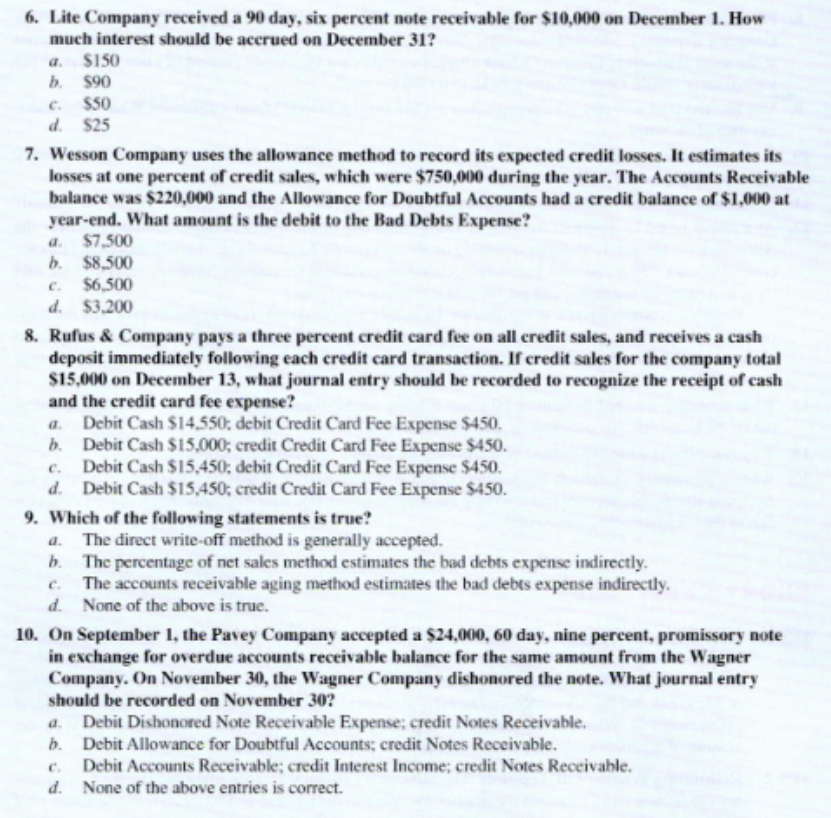Please solve all the MCQ with detailed answer for both correct and incorrect answers
Please solve all the MCQ with detailed answer for both correct and incorrect answers
College Accounting, Chapters 1-27
23rd Edition
ISBN:9781337794756
Author:HEINTZ, James A.
Publisher:HEINTZ, James A.
Chapter16: Accounting For Accounts Receivable
Section: Chapter Questions
Problem 9SPB: UNCOLLECTIBLE ACCOUNTSPERCENTAGE OF SALES AND PERCENTAGE OF RECEIVABLES At the completion of the...
Related questions
Question
Practice Pack
Please solve all the MCQ with detailed answer for both correct and incorrect answers

Transcribed Image Text:6. Lite Company received a 90 day, six percent note receivable for $10,000 on December 1. How
much interest should be accrued on December 31?
a.
$150
b. $90
C.
$50
d. $25
7. Wesson Company uses the allowance method to record its expected credit losses. It estimates its
losses at one percent of credit sales, which were $750,000 during the year. The Accounts Receivable
balance was $220,000 and the Allowance for Doubtful Accounts had a credit balance of $1,000 at
year-end. What amount is the debit to the Bad Debts Expense?
$7,500
b. $8,500
d.
C.
$6,500
d. $3,200
8. Rufus & Company pays a three percent credit card fee on all credit sales, and receives a cash
deposit immediately following each credit card transaction. If credit sales for the company total
$15,000 on December 13, what journal entry should be recorded to recognize the receipt of cash
and the credit card fee expense?
a. Debit Cash $14,550; debit Credit Card Fee Expense $450.
Debit Cash $15,000; credit Credit Card Fee Expense $450.
Debit Cash $15,450; debit Credit Card Fee Expense $450.
Debit Cash $15,450; credit Credit Card Fee Expense $450.
9. Which of the following statements is true?
a. The direct write-off method is generally accepted.
The percentage of net sales method estimates the bad debts expense indirectly.
The accounts receivable aging method estimates the bad debts expense indirectly.
d. None of the above is true.
10. On September 1, the Pavey Company accepted a $24,000, 60 day, nine percent, promissory note
in exchange for overdue accounts receivable balance for the same amount from the Wagner
Company. On November 30, the Wagner Company dishonored the note. What journal entry
should be recorded on November 30?
a. Debit Dishonored Note Receivable Expense; credit Notes Receivable.
b. Debit Allowance for Doubtful Accounts; credit Notes Receivable.
Debit Accounts Receivable; credit Interest Income; credit Notes Receivable.
C.
d. None of the above entries is correct.
Expert Solution
This question has been solved!
Explore an expertly crafted, step-by-step solution for a thorough understanding of key concepts.
This is a popular solution!
Includes step-by-step video
Trending now
This is a popular solution!
Learn your way
Includes step-by-step video
Step by step
Solved in 3 steps

Knowledge Booster
Learn more about
Need a deep-dive on the concept behind this application? Look no further. Learn more about this topic, accounting and related others by exploring similar questions and additional content below.Recommended textbooks for you

College Accounting, Chapters 1-27
Accounting
ISBN:
9781337794756
Author:
HEINTZ, James A.
Publisher:
Cengage Learning,

Intermediate Accounting: Reporting And Analysis
Accounting
ISBN:
9781337788281
Author:
James M. Wahlen, Jefferson P. Jones, Donald Pagach
Publisher:
Cengage Learning

Principles of Accounting Volume 1
Accounting
ISBN:
9781947172685
Author:
OpenStax
Publisher:
OpenStax College

College Accounting, Chapters 1-27
Accounting
ISBN:
9781337794756
Author:
HEINTZ, James A.
Publisher:
Cengage Learning,

Intermediate Accounting: Reporting And Analysis
Accounting
ISBN:
9781337788281
Author:
James M. Wahlen, Jefferson P. Jones, Donald Pagach
Publisher:
Cengage Learning

Principles of Accounting Volume 1
Accounting
ISBN:
9781947172685
Author:
OpenStax
Publisher:
OpenStax College

College Accounting (Book Only): A Career Approach
Accounting
ISBN:
9781337280570
Author:
Scott, Cathy J.
Publisher:
South-Western College Pub

Intermediate Financial Management (MindTap Course…
Finance
ISBN:
9781337395083
Author:
Eugene F. Brigham, Phillip R. Daves
Publisher:
Cengage Learning

EBK CONTEMPORARY FINANCIAL MANAGEMENT
Finance
ISBN:
9781337514835
Author:
MOYER
Publisher:
CENGAGE LEARNING - CONSIGNMENT